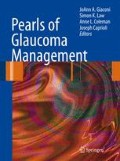Abstract
The question can be answered in many ways. First of all, there are visual field devices used to perform automated static perimetry and those for manual kinetic perimetry. Automatedtests utilize computer programs to vary test speed, target size, and luminance. Automated tests also benefit from standardized testing conditions, which can be used to interpret results across machines, and efficient testing strategies (more on these later). They present light stimuli of varying luminance to the patient in specific locations for a given duration of time before the next stimulus is presented (0 dB is a maximal stimulus intensity, 10 dB is 1-log unit lower than the maximum, 20 dB is 2 log-units lower, etc). Automated devices provide results that can be directly compared to age-adjusted normative values, which have been derived from testing hundreds of normal subjects. Commonly used automated perimeters are the Humphrey visual field analyzer (HFA) (Zeiss, Inc., Dublin, CA) and the Octopus perimeter (Interzeag/Haag Streit, Koeniz, Switzerland). Manualperimeters require a skilled examiner to present targets to the patient. Both static and kinetic testing can be performed manually. In kinetic testing, a moving target of varying size and luminance is presented to the patient. Manual kinetic perimetry is more flexible and interactive for the patient, and it provides the opportunity to evaluate the far peripheral visual field [1]. Also in existence is a semi-automated kinetic perimetry program on the Octopus perimeter in which a computer program performs kinetic perimetry.
Access this chapter
Tax calculation will be finalised at checkout
Purchases are for personal use only
References
Anderson DR, Patella VM (1999) Automated Static Perimetry. Mosby, St. Louis.
Bengtsson B, Olsson J, Heijl A, et al (1997) A new generation of algorithms for computerized threshold perimetry, SITA. Acta Ophthalmol Scand 75: 368–375.
Anderson AJ, Johnson CA (2006) Comparison of the ASA, MOBS and ZEST threshold methods. Vision Res 46: 2403–2411.
Gonzales de la Rosa M, Morales J, et al (2003) Multicenter evaluation of tendency-oriented perimetry (TOP) using the G1 grid. Eur J Ophthalmol 13: 32–34.
Weijland A, Fankhauser F, Bebie H, Flammer J (2004) Automated perimetry. Visual field digest, 5th ed. Haag streit, Koeniz, Switzerland.
Demirel S, Johnson CA (1996) Short wavelength automated perimetry (SWAP) in ophthalmic practice. J Am Optom Assoc 67: 451–456.
Racette, Sample PA (2003) Short wavelength automated perimetry. In: Sample PA, Girkin CA (eds), Ophthalmology Clinics of North America. W.B. Saunders, Philadelphia, pp. 227–236.
Frisen L (1993) High pass resolution perimetry. A clinical review. Doc Ophthalmol 83: 1–25.
Frisen L (2002) New, sensitive window on abnormal spatial vision: Rarebit probing. Vision Res 42: 1931–1939.
McKendrick AM, Johnson CA (2002) Visual perception: temporal properties of vision. In: Alm A, Kaufmann P (eds), Adler’s Physiology of the Eye. C.V. Mosby, St. Louis, pp. 511–530.
Quaid PT, Flanagan JG (2005) Defining the limits of flicker-defined form: effect of stimulus size, eccentricity and number of random dots. Vision Res 45: 1075–1084.
Wall M (2004) What’s new in perimetry. J Neuroophthalmol 24: 46–55.
Anderson AJ, Johnson CA (2003) Frequency-doubling technology perimetry. In: Sample PA, Girkin CA (eds), Ophthalmology Clinics of North America. W.B. Saunders, Philadelphia, pp. 213–225.
Anderson AJ, Johnson CA, Fingeret M, et al (2005) Characteristics of the normative database for the Humphrey Matrix perimeter. Inv Ophthalmol Vis Sci 46: 1540–1548.
Bengtsson B, Heijl A (1998) SITA Fast, a new rapid perimetric threshold test. Description of methods and evaluation in patients with manifest and suspect glaucoma. Acta Ophthalmol Scand 76: 431–443.
Artes, PH, Iwase A, Ohno Y, et al. (2002) Properties of perimetric threshold estimates from Full Threshold, SITA Standard and SITA Fast strategies. Inv Ophthalmol Vis Sci 43: 2654–2659.
Johnson CA, Wall M, Fingeret M, Lalle P (1998) A Primer For Frequency Doubling Technology Perimetry. Welch Allyn, Skaneateles, New York
Gardiner SL, Anderson DR, Fingeret M, et al (2006) Evaluation of decision rules for frequency doubling technology (FDT) screening tests. Opt Vis Sci 83: 432–437.
Johnson CA, Cioffi GA, Van Buskirk EM (1999) Evaluation of two screening tests for frequency doubling technology perimetry. In: Perimetry Update 1998/1999. Kugler, Amsterdam, pp. 103–109.
Keltner JL, Johnson CA, Beck, RW, et al.; Optic Neuritis Study Group (1993). Quality control functions of the Visual Field Reading Center (VFRC) for the Optic Neuritis Treatment Trial (ONTT). Control Clin Trials 14: 143–159.
Keltner, JL, Johnson CA, Spurr JO, et al.; Ocular Hypertension Study Group (2000) Confirmation of visual field abnormalities in the Ocular Hypertension Treatment Study (OHTS). Arch Ophthalmol 118: 1187–1194.
Keltner JL, Johnson CA, Cello KE, et al (2007) Visual field quality control in the Ocular Hypertension Treatment Study (OHTS). J Glaucoma 16: 665–669.
Johnson CA, Keltner JL (1998) Principles and techniques of the examination of the visual sensory system. In: Miller NR, Newman NJ (eds), Walsh and Hoyt’s Textbook of Neuro-Ophthalmology. Lippincott Williams & Wilkins, Baltimore, pp. 153–235.
Quinn LM, Wheeler DT, Gardiner SK, et al (2006) Frequency doubling technology (FDT) perimetry in normal children. Am J Ophthalmol 142: 983–989.
Hong S, Narkiewicz J, Kardon RH (2001) Comparison of pupil perimetry and visual perimetry in normal eyes: decibel sensitivity and variability. Inv Ophthalmol Vis Sci 42: 957–965.
Hood DC, Greenstein VC (2003) Multifocal VEP and ganglion cell damage: applications and limitations for the study of glaucoma. Prog Retin Eye Res 22: 201–251.
Author information
Authors and Affiliations
Corresponding author
Editor information
Editors and Affiliations
Rights and permissions
Copyright information
© 2010 Springer-Verlag Berlin Heidelberg
About this chapter
Cite this chapter
Johnson, C.A. (2010). Visual Fields: Visual Field Test Strategies. In: Giaconi, J., Law, S., Coleman, A., Caprioli, J. (eds) Pearls of Glaucoma Management. Springer, Berlin, Heidelberg. https://doi.org/10.1007/978-3-540-68240-0_15
Download citation
DOI: https://doi.org/10.1007/978-3-540-68240-0_15
Published:
Publisher Name: Springer, Berlin, Heidelberg
Print ISBN: 978-3-540-68238-7
Online ISBN: 978-3-540-68240-0
eBook Packages: MedicineMedicine (R0)

